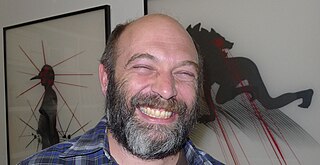
Bastiaan Johan Christiaan "Bas Jan" Ader was a Dutch conceptual and performance artist, and photographer. His work was in many instances presented as photographs and film of his performances. He made performative installations, including Please Don't Leave Me (1969).
James Lee Byars was an American conceptual artist and performance artist specializing in installations and sculptures, as well as a self-considered mystic. He was best known for his use of personal esoteric motifs, and his creative persona that has been described as 'half dandified trickster and half minimalist seer'.

John Currin is an American painter based in New York City. He is most recognised for his technically proficient satirical figurative paintings that explore controversial sexual and societal topics. His work shows a wide range of influences, including sources as diverse as the Renaissance, popular culture magazines, and contemporary fashion models. He often distorts or exaggerates the erotic forms of the female body, and has stressed that his characters are reflections of himself rather than inspired by real people.
A kunsthalle is a facility that mounts temporary art exhibitions, similar to an art gallery. It is distinct from an art museum by not having a permanent collection.

Jean-Marc Bustamante is a French artist, painter, sculptor and photographer. He is a noted conceptual and installation artist and has incorporated ornamental design and architectural space in his works.

Pierre Bismuth is a French artist and filmmaker based in Brussels. His practice can be placed in the tradition of conceptual art and appropriation art. His work uses a variety of media and materials, including painting, sculpture, collage, video, architecture, performance, music, and film. He is best known for being among the authors of the story for Eternal Sunshine of the Spotless Mind (2004), for which he won the Academy Award for Best Original Screenplay alongside Michel Gondry and Charlie Kaufman. Bismuth made his directorial debut with the 2016 feature film Where is Rocky II?.

Lucebert was a Dutch artist who first became known as the poet of the COBRA movement.

Ralf Winkler, alias A. R. Penck, who also used the pseudonyms Mike Hammer, T. M., Mickey Spilane, Theodor Marx, "a. Y." or just "Y" was a German painter, printmaker, sculptor, and jazz drummer. A neo-expressionist, he became known for his visual style, reminiscent of the influence of primitive art.

Carlos Amorales is a multidisciplinary artist who studied at the Gerrit Rietveld Academy and the Rijksakademie in Amsterdam. The most extensive researches in his work encompass Los Amorales (1996-2001), Liquid Archive (1999–2010), Nuevos Ricos (2004–2009), and a typographic exploration in junction with cinema (2013–present).

Guillaume Bijl is a Belgian conceptual and an installation artist. He lives and works in Antwerp.

Terry Alan Fox was an American conceptual artist known for his work in performance art, video, and sound. He was of the first generation conceptual artists and was a central participant in West Coast performance art, video and conceptual art movements of the late 1960s and early 1970s. Fox was active in San Francisco and in Europe, living in Europe in the latter portion of his life.

Antonio Jose Guzman is a Dutch Panamanian visual artist, communication designer and lecturer. He lives and works in Amsterdam, Panama City and Dakar.
Tim White-Sobieski is a video and installation artist based in New York and Berlin. He was educated as an architect and dedicated himself to visual art and filmmaking, exploring the fields of painting, sculpture, photography, video, video installations and light installations throughout his career. He began showing in New York in the early 1990s with his "Blue Paintings." Emphasis on the role of the subconscious in his paintings had affinities with visual abstractionism and literary existentialism.

Gabriel Lester is an inventor, visual artist and film director living and working in Amsterdam.

The Fridericianum is a museum in Kassel, Germany. Built in 1779, it is one of the oldest public museums in Europe. Since 1955 the quinquennial art festival documenta has been centred on the site, with some artworks displayed on Friedrichsplatz, in front of the building.
Athanasios Argianas is a Greek and British artist living and working in London, England. Argianas' practice is interdisciplinary; incorporating sculpture, painting, text, performance and often music or sound, and concerns itself with metaphorical or translated representations of aural experiences. He received his MA from Goldsmiths College, London and previously studied under Jannis Kounellis at the Kunstakademie Düsseldorf.
Libia Castro and Ólafur Ólafsson are collaborative artists based in Rotterdam and Berlin.

Constant Dullaart is a Dutch conceptual artist, media artist, internet artist, and curator. His work is deeply connected to the Internet.

Tabor Robak is an American contemporary artist working in New Media, living in Paris, France. Robak is primarily known for his trailblazing digital art practice, multi-channel video installations and generative artworks. Robak's work has been exhibited and collected internationally at renowned institutions such as Museum of Modern Art, Serpentine, National Gallery of Victoria, Albright Knox, and Migros Museum. In 2014, Robak was named in Forbes 30 Under 30 in Art. Robak has guest lectured MFA students at Yale and co-taught an MFA course on real time 3D at New York University.
Guillaume Leblon is a French sculptor and visual artist. He lives and works in New York City.













